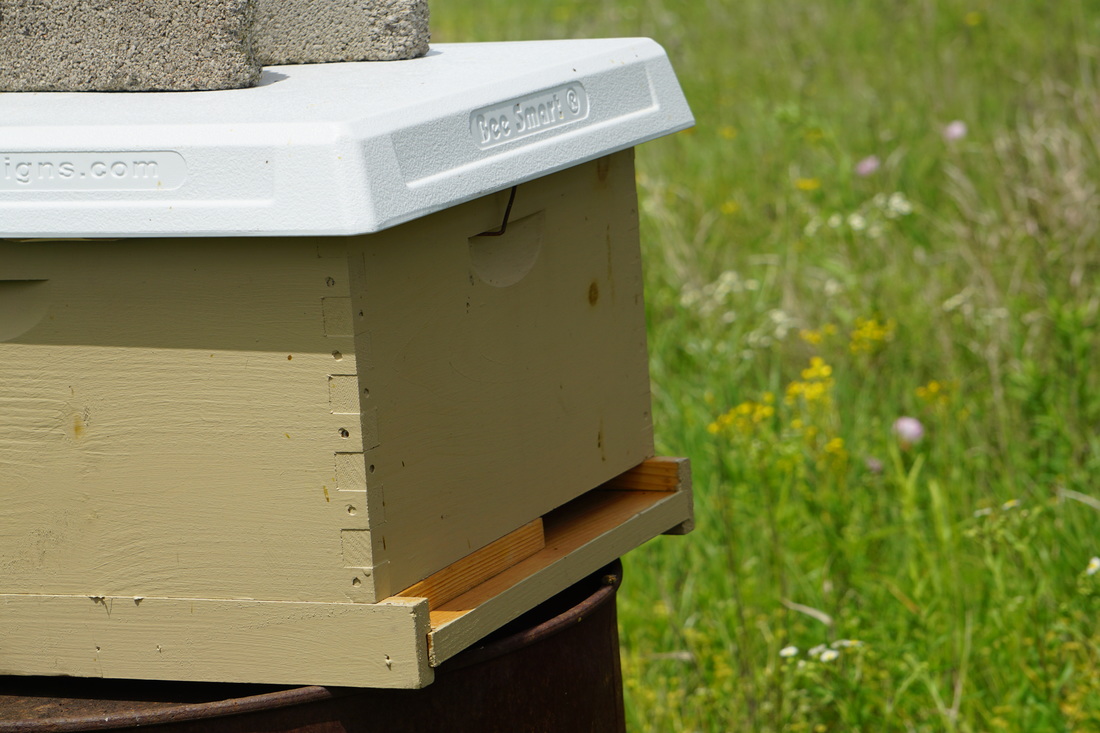|
It's been a while since we have given an update on the bees. For a quick review, back in March we bought a "Resource Hive", which is pictured above. This hive is the same size as the standard Langstroth Hive. However, it has a permanent wall going down the middle of the hive body. This enables you to house two nuc hives in one box. One hive has an opening in the back, and the other, as seen in this photo, has an opening in the front. Each side of the hive can hold 4 deep frames. As the nuc grows in strength, you can add another box on top with another four frames. When the bees have increased in number and strength, you can then take all eight frames out and put them in a ten frame brood box, with one or two additional empty frames, to create a new hive. Currently, we are only putting nine frames in our brood boxes. This gives a little extra room between frames, making it a little easier to remove and move them around. The hope is that we will not kill the queen during inspections as easily when pulling frames in and out. When the other side of the resource hive is strong, you can then move those eight frames out as well, creating a second new hive. Back in March we used this box for a couple of first time 'experiments' as fairly new beekeepers. We had a very weak hive. However, it still had a queen. We took four frames with the queen, and all the bees we could get, out of the weak hive and put them in one side of the resource hive. Only two or three frames really had any bees on them. We then added a sheet of newspaper and the deep box that goes on this half of the resource hive. In the upper box we added four frames from one of our stronger hives, choosing frames with lots of brood and bees. These bees would chew through the newspaper and join the hive below, giving them time to adjust to the pheromone of their new queen below. This prevents fighting and the possible killing of the queen. As all the brood above hatches, the hive will grow stronger very quickly, while the queen below continues to lay eggs. For the other half of the resource hive, we removed four frames full of bees, capped brood, uncapped brood, and eggs. The goal here was for the bees to make their own queen from one of the eggs. In the box above, we just added four frames of empty drawn comb we had at the farm with the intention that the bees would use this for pollen, honey and more brood if needed. Both of these procedures are very acceptable practices for creating hives from splits and weaker hives. The other "new" variable we threw in there, that, in hindsight, we should not have, was a new type of hive cover. Though the cover does seem to be a good, it's not appropriate for the resource hive as I will explain later. The results or our attempted save/split..... Not the win/win as expected, but a win with lessons learned. The new cover I just mentioned above, well, it has crawl-space type grooves on the underside which are located in areas which I believe allowed the possible mixture of bees between the two hives. But I can't say this for certain. When we moved the first half of the resource hive to a ten frame brood box, we did not see a queen or brood. This was the side which originally had a queen. It seemed even weaker. I'm thinking maybe it had possibly swarmed due to overcrowding. During one inspection, this half of the hive was very full of bees. Due to rainy weather, we were not able to transfer the hive as soon as intended. The nuc on the other side, which was originally queenless, was strong with brood AND it now had a queen! This means we succeeded in having a hive to create it's own queen, or, the queen from the other side made the move to this side from the crawl spaces on the underside of the top cover. There is no way to be sure as to what really happened. Though it's not the win/win of two strong hives we expected, it's still a win. We did get one strong hive out of the deal to replace a very weak hive we would have probably lost anyway.
0 Comments
Leave a Reply. |
A Mattingly
Artist, Writer, Holistic Living Guide Important Disclaimer: Any content discussing medicinal uses of plants, herbs, or food as medicine is informational only and not prescriptive. When dealing with health issues, be sure to do your own research and consult with the appropriate health professional for guidance. These statements have not been evaluated by the FDA. It is information based on my personal research and studies.
Categories
All
Archives
September 2023
|


 RSS Feed
RSS Feed